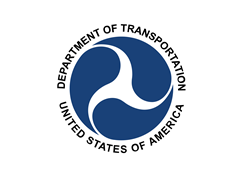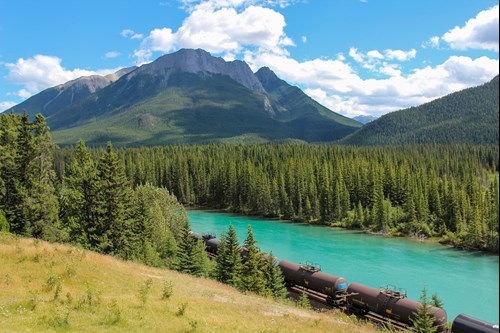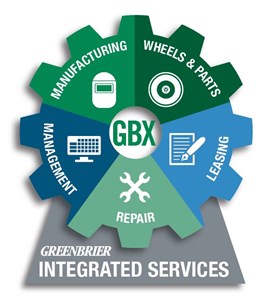By James Rader
Summary:
On Wednesday, November 25, 2020, the Department of Transportation (DOT) issued a final rule that adopted industry petitions with respect to the rail transportation of toxic-by-inhalation materials (TIH) (HM-219C [85 FR 75680]). Among other things, the final rule prohibits the transportation of a TIH material in a tank car constructed of non-normalized steel after December 31, 2020, and phases out the use of tank cars that do not meet the federal safety standards issued under Docket HM-246 by December 31, 2027. The final rule also changed the last letter in the tank specification from “I” to “W” to remove the reference of the “interim” tank car standard. The final rule also changed the delimiter “J” to “H” to show the enhanced safety features of the car. For example, DOT105J600I to DOT 105H600W (see Docket HM-246, dated January 13, 2009, 74 FR 1770).
Which commodities are impacted?
Column 1 names TIH materials and column 2 names the authorized tank car.
| Toxic-by-Inhalation Materials | Authorized Tank Car |
| Acetone cyanohydrin, stabilized | 105H500W, 112H500W |
| Acrolein | 105H600W |
| Allyl Alcohol | 105H500W, 112H500W |
| Anhydrous ammonia, or ammonia solutions > 50 percent ammonia | 105H500W, 112H500W |
| Bromine | 105H500W |
| Chlorine | 105H600W |
| Chloropicrin | 105H500W, 112H500W |
| Chlorosulfonic acid | 105H500W, 112H500W |
| Dimethyl sulfate | 105H500W, 112H500W |
| Dinitrogen tetroxide, inhibited | 105H500W |
| Division 2.3 Zone A materials not specifically identified in this table | 105H600W |
| Division 2.3 Zone B materials not specifically identified in this table | 105H600W |
| Division 2.3 Zone C materials not specifically identified in this table | 105H500W |
| Division 2.3 Zone D materials not specifically identified in this table | 105H500W, 112H500W |
| Ethyl chloroformate | 105H500W, 112H500W |
| Ethylene oxide | 105H500W, 112H500W |
| Hexachlorocyclopentadiene | 105H500W, 112H500W |
| Hydrocyanic acid, aqueous solution or Hydrogen cyanide, aqueous solution with not more than 20% hydrogen cyanide | 105H500W, 112H500W |
| Hydrogen chloride, refrigerated liquid | 105H600W, 112H600W |
| Hydrogen cyanide, stabilized | 105H600W |
| Hydrogen fluoride, anhydrous | 105H500W, 112H500W |
| Hydrogen sulfide | 105H600W |
| Methyl bromide | 105H500W |
| Methyl mercaptan | 105H500W |
| Nitrosyl chloride | 105H500W |
| Phosphorus trichloride | 105H500W, 112H500W |
| Poison (Toxic) inhalation hazard (Classes 3-8), Zone A materials not specifically identified in this table | 105H600W |
| Poison (Toxic) inhalation hazard (Classes 3-8), Zone B materials not specifically identified in this table | 105H500W, 112H500W |
| Sulfur dioxide, liquefied | 105H500W |
| Sulfur trioxide, stabilized | 105H500W, 112H500W |
| Sulfuric acid, fuming | 105H500W, 112H500W |
| Titanium tetrachloride | 105H500W, 112H500W |
Rule-making Background:
For hazardous materials transported in the United States, the DOT has Congressional authority to prescribe regulations for the safe transportation, including the security of hazardous material in intrastate, interstate, and foreign commerce. The Secretary’s regulations apply to: (1) persons that cause hazardous materials to be transported in commerce; (2) persons who transport hazardous materials in commerce; and (3) persons that design, manufacture, fabricate, inspect, mark, maintain, recondition, repair or test a package, container, or packaging component, that is represented, marked, certified or sold as qualified for use in transporting hazardous material in commerce. For more than a century, and as an assigned role by DOT, the federal regulations authorized the Association of American Railroads (AAR) and its predecessors to review tank car applications, set welding and repair standards, and to approve the design of valves and fittings.

In addition to this DOT assigned role, the AAR may impose other safety standards on the cars, including placing railroad operating requirements on the handling of the cars under its “Interchange Rules.” The Interchange Rules govern the movement of freight cars on the general railroad system of transportation. All freight railroads, interchange freight railcar owners, and running repair agents must subscribe to the AAR rules.
AAR CPC-1178
Acting under its Interchange Rules, on December 18, 2006, the AAR issued Casualty Prevention Circular (“CPC”) CPC-1178, to enhance the crashworthiness of a tank transporting anhydrous ammonia and chlorine when subjected to a derailment or collision. The circular required that on January 1, 2008, newly ordered tank cars for anhydrous ammonia service must conform to specification DOT 112J500W and for chlorine service must conform to specification DOT 105J600W. For both products, the AAR required equipping railcars with full-height ½-inch thick head shields and with top-fitting protection capable of withstanding a 9-mph rollover.
AAR CPC-1184
On November 2, 2007, the AAR issued CPC-1184, which expanded the AAR tank car design standard to include other TIH materials. The AAR considered existing tank cars that conformed to the requirement in compliance. Tank car owners were to provide implementation plans to the AAR by December 31, 2008, with progress reports by March 31 of each year beginning in 2010.
AAR CPC-1185
On November 20, 2007, at the request of the FRA Administrator, the AAR issued CPC-1185 postponing January 1, 2008, effective date until March 31, 2008.
AAR CPC-1187
On March 31, 2008, the AAR issued CPC-1187 further postponing the effective date until April 30, 2008. Tank car owners were to supply plans to the AAR for approval showing that the owner’s fleet would comply with the new AAR design standard by December 31, 2018.
DOT Docket HM-246
In response to government and industry efforts, on January 13, 2009, under Docket HM-246, the DOT issued new tank car safety regulations for the transportation of TIH materials. See DOT Docket HM-246 dated January 13, 2009 (74 FR 1770). Docket HM-246 recognized the DOT “interim design standard” as an appropriate design for TIH materials, which required the construction of a tank car built on or after March 16, 2009, to have a tougher and thicker tank shell and heads, stand-alone full-height head shields, and top-fitting protection capable of surviving a 9-mph rollover. The DOT adopted the interim design standard in anticipation that the AAR, FRA, and the industry would research and develop a final design that had greater accident survivability. An important aspect of the Docket HM-246 was the “grandfathering” of the continued use of tank cars built prior to March 16, 2009, if the AAR had already approved such cars for TIH material service. The docket also placed a 20-year life-limit on newly built tank cars.

DOT Docket HM-219A
Based on a Chlorine Institute (P-1636) petition for rulemaking, on November 7, 2018, DOT published a final rule removing the 20-year life-limit effective on December 7, 2018 (see HM-219A, 83 FR 55792).
AAR CPC-1211
After the issuance of the DOT final rule, on April 12, 2010, and in support of the continuation of AAR, FRA and industry research, the AAR issued CPC-1211 placing CPC-1187 in suspension.
Industry Agreement
In a cooperative industry effort, and to improve transportation safety, on April 27, 2018, the AAR, American Chemistry Council, the Chlorine Institute and the Fertilizer Institute signed an agreement to work together to phase-out tank cars that did not conform to the new HM-246 safety regulations by December 31, 2027. The agreement included a requirement to jointly petition DOT to speed up a rulemaking to enact the industry’s phase-out agreement.
DOT Docket HM-219C
Acting on the industry’s petition, on November 25, 2020, DOT issued a final rule under Docket HM-219C; thereby, adopting the AAR interchange standard and industry agreement by prohibiting the movement of TIH materials in tank cars constructed of non-normalized steel after December 31, 2020, and the phase-out of tank cars that do not meet the HM-246 federal safety standards by December 31, 2027.
Shortly after publication of the Docket HM-219C federal register notice, Greenbrier, in cooperation with the Railway Supply Institute, discussed needed changes to the final rule. These changes include, among other things: (1) authorization to mark tank cars built to the new standard prior to publication of the final rule with an “H” delimiter; (2) removal of the restriction on the use of tank cars marked with an “H” delimiter for other non-PIH materials; and (3) clarification of the safety system requirements for each of the authorized delimiters, such as “J,” “S,” “T,” and “H.” Greenbrier continues to peruse these changes in cooperation with other industry stakeholders.
Compliance to Standards:
Greenbrier follows rail industry rulemaking proceedings very closely. Our regulatory compliance and asset management team has decades of experience helping fleet owners navigate compliance issues, and our engineering team continues to collaborate with shippers to develop unique railcar designs that aim for improved safety and efficiency.
As the impact of the new tank car TIH rulemaking proceeding becomes clearer, we will continue to update this article. In the meantime, please do not hesitate to contact us with any questions regarding the design, construction, operation or maintenance of any type of rail car.

——————————————————
James H. Rader (Jim) has more than four decades of railroad industry experience that includes service at the Federal Railroad Administration, the Association of American Railroads, and two Class I railroads. Currently, Jim serves on the Surface Transportation Board’s (STB) Rail Energy Technical Advisory Committee, the AAR Tank Car Committee, the Canadian General Standards Board Committee on Tank Cars, and is a Board Member of the Railcar Technical Services Association (RTSA). He is also a regular contributor at the FRA Railroad Safety Advisory Committee (RSAC) and staff writer for the Journal of HazMat Transportation. Jim holds a Bachelor of Science Degree from Strayer University in Business Administration.
In his current role, Jim serves as a leader in the development of regulatory compliance programs for Greenbrier Companies, its subsidiaries, and Greenbrier’s customers. Currently, Jim is the Vice President of Regulatory Management, which provides services for customers in transportation regulatory compliance, railcar fleet management, quality management systems, railcar reliability and maintenance standards, railroad accident and incident investigations, hazardous material and railcar training, federal claims mitigation and support for rail-related litigation.

